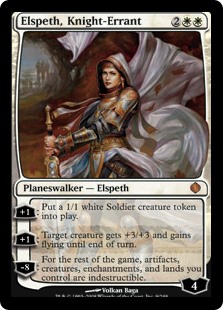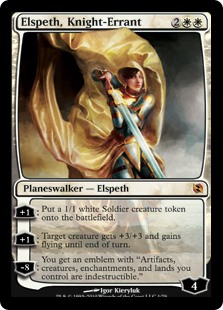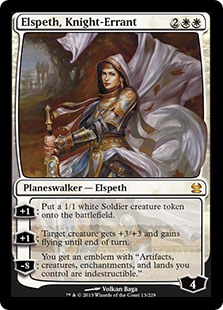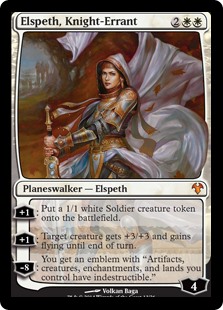2011-01-01
Emblems behave similarly to enchantments: They have an ability that, in a general sense, continually affects the game. The primary difference between them is that emblems aren't permanents and don't exist on the battlefield. Nothing in the game can remove an emblem, simply because no other spell or ability references them. Once you get an emblem, you keep it for the rest of the game. Emblems have no color, name, card type, or other characteristics beyond the listed ability
2013-07-01
Lethal damage and effects that say "destroy" won't cause a permanent with indestructible to be put into the graveyard. However, a permanent with indestructible can be put into the graveyard for a number of reasons. The most likely reasons are if it's sacrificed, if it's a creature whose toughness is 0 or less, or if it's an Aura that's either unattached or attached to something illegal.
2013-07-01
Planeswalkers are permanents. You can cast one at the time you could cast a sorcery. When your planeswalker spell resolves, it enters the battlefield under your control.
2013-07-01
Planeswalkers are not creatures. Spells and abilities that affect creatures won’t affect them.
2013-07-01
Planeswalkers have loyalty. A planeswalker enters the battlefield with a number of loyalty counters on it equal to the number printed in its lower right corner. Activating one of its abilities may cause it to gain or lose loyalty counters. Damage dealt to a planeswalker causes that many loyalty counters to be removed from it. If it has no loyalty counters on it, it’s put into its owner’s graveyard as a state-based action.
2013-07-01
Planeswalkers each have a number of activated abilities called “loyalty abilities.” You can activate a loyalty ability of a planeswalker you control only at the time you could cast a sorcery and only if you haven’t activated one of that planeswalker’s loyalty abilities yet that turn.
2013-07-01
The cost to activate a planeswalker’s loyalty ability is represented by a symbol with a number inside. Up-arrows contain positive numbers, such as “+1”; this means “Put one loyalty counter on this planeswalker.” Down-arrows contain negative numbers, such as “-7”; this means “Remove seven loyalty counters from this planeswalker.” A symbol with a “0” means “Put zero loyalty counters on this planeswalker.”
2013-07-01
You can’t activate a planeswalker’s ability with a negative loyalty cost unless the planeswalker has at least that many loyalty counters on it.
2013-07-01
Planeswalkers can’t attack (unless an effect turns the planeswalker into a creature). However, they can be attacked. Each of your attacking creatures can attack your opponent or a planeswalker that player controls. You say which as you declare attackers.
2013-07-01
If your planeswalkers are being attacked, you can block the attackers as normal.
2013-07-01
If a creature that’s attacking a planeswalker isn’t blocked, it’ll deal its combat damage to that planeswalker. Damage dealt to a planeswalker causes that many loyalty counters to be removed from it.
2013-07-01
If a source you control would deal noncombat damage to an opponent, you may have that source deal that damage to a planeswalker that opponent controls instead. For example, although you can’t target a planeswalker with Shock, you can target your opponent with Shock, and then as Shock resolves, choose to have Shock deal its 2 damage to one of your opponent’s planeswalkers. (You can’t split up that damage between different players and/or planeswalkers.) If you have Shock deal its damage to a planeswalker, two loyalty counters are removed from it.
2013-07-01
If a player controls two or more planeswalkers that share a planeswalker type, that player chooses one of them and the rest are put into their owners’ graveyards as a state-based action.
 Shards of Alara
Shards of Alara



 Elspeth, Knight-Errant Shards of Alara - Mythic Rare
Elspeth, Knight-Errant Shards of Alara - Mythic Rare
 Elspeth, Knight-Errant Duel Decks: Elspeth vs. Tezzeret - Mythic Rare
Elspeth, Knight-Errant Duel Decks: Elspeth vs. Tezzeret - Mythic Rare












